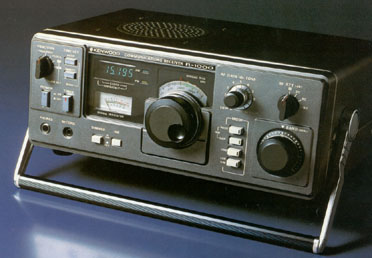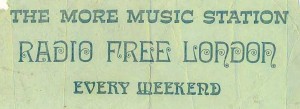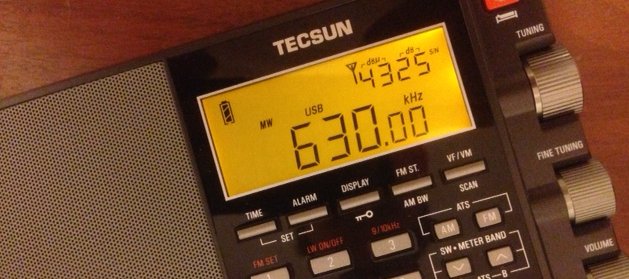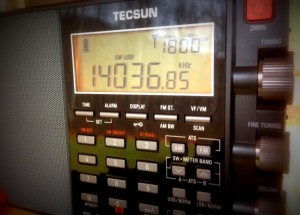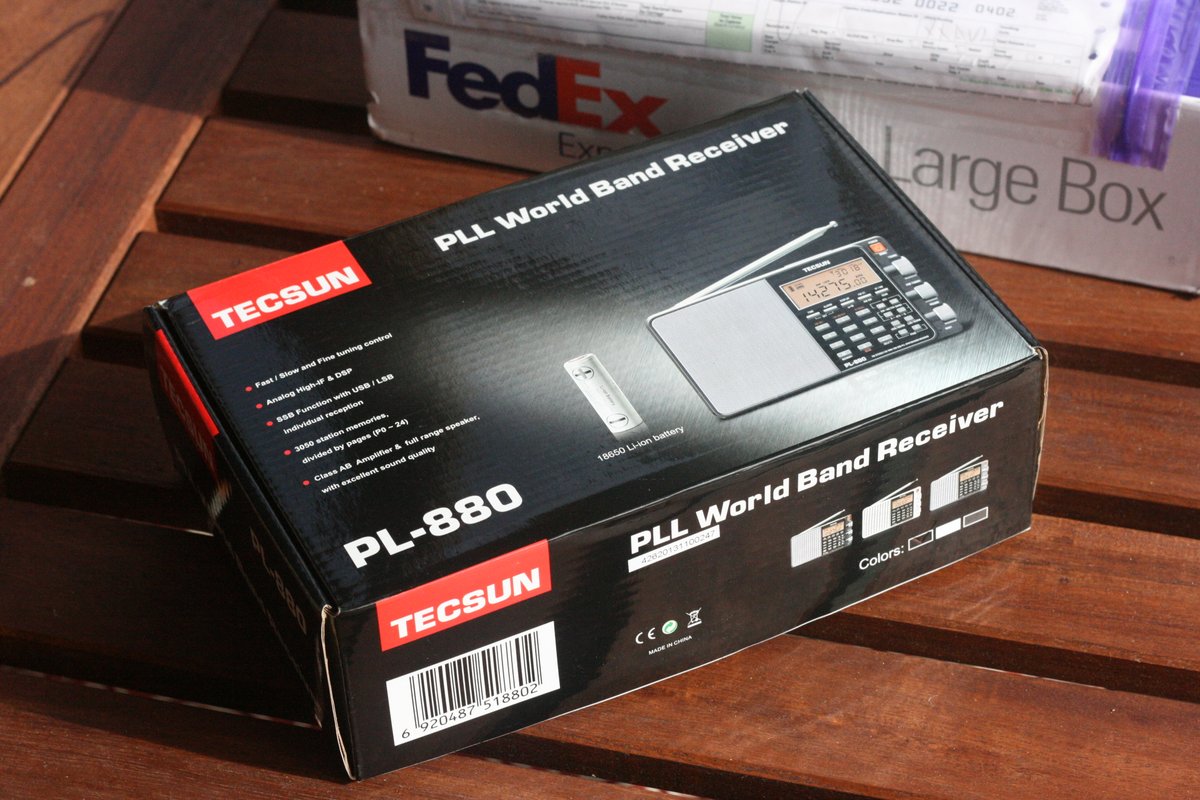
I have never seen such a eager response and extraordinary anticipation over the announcement of a new portable radio as with the new Tecsun PL-880. And I’m not surprised. You see, it has been a couple years since a really good portable radio has been introduced to the market. Plus,Tecsun has proven itself a competent radio manufacturer; the predecessors to the PL-880–i.e., the PL-660 and PL-600–are both excellent portables (I own both). Their smaller DSP radios are favorites of travelers and ultralight enthusiasts.
As I was telling Jeff, over at the Herculodge blog, reviewing the PL-880 was much like attending the opening night of a play. My wife, who has worked in theatre, once told me, “the audience wants the actors to perform well.” The moment I held the PL-880 in my hands, I felt the same: I really wanted this to be a great performer, a new radio companion with which I could track down signals both weak and strong.
But what does the PL-880 actually deliver? Let’s take a look…
Drumroll, please….and now, the PL-880
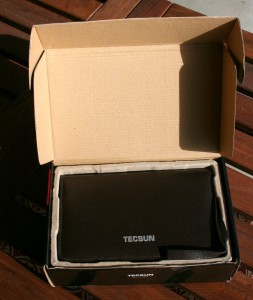 I purchased/pre-ordered my Tecsun PL-880 from my favorite eBay seller, Anon-Co, as I’ve always been pleased with their customer service and delivery time. They’re based in Hong Kong, but my shipping time from Hong Kong via FedEx was only three days before the radio landed in my mailbox.
I purchased/pre-ordered my Tecsun PL-880 from my favorite eBay seller, Anon-Co, as I’ve always been pleased with their customer service and delivery time. They’re based in Hong Kong, but my shipping time from Hong Kong via FedEx was only three days before the radio landed in my mailbox.
Unlike past reviews, in which I simply post initial impressions with a full review later, I elected to spill some of my early findings on the SWLing Post as I discovered them. On the recommendation of a reader, I even photographed the unboxing; I’m glad I did, too, as it felt a bit like taking pictures of a Christmas gift being opened…which was even merrier.
I was happy to see that the PL-880 was packed carefully but with very little waste. Included with the radio was a rechargeable battery, earbud headphones, a wire antenna, and a USB power cable; Anon-Co also also sent a USB wall adapter plug. The carrying case, which holds the PL-880 and its manual, is substantial, reminding me of carrying cases that used to ship with portables some time ago.
The PL-880 is almost identical in size to the PL-660 and PL-600. The buttons have a highly tactile response, the tuning/volume wheels are very smooth, and feel well-engineered. The display is back-lit and has a dedicated switch on the right side of the radio–meaning that if you turn on the back-lighting, it will stay on, even if you turn off the radio.
The PL-880 has all of the connections and controls I could have wished for in a portable. On the left side of the radio, it has an external antenna jack, a three-position antenna gain switch (DX, Norm, Local), a headphone jack, a line-out jack, and a 5 VDC USB input. On the right side panel, you’ll find the main tuning knob, fine-tuning knob, the volume, the back-light switch, and a tone control switch (bass/treble). On the top panel of the radio, there is also a “snooze” button.
When I turned on the PL-880 for the first time and (ironically) tuned to a local AM station on 880 kHz, I was most impressed by the audio fidelity of the 880’s built-in speaker. I believe the PL-880 uses a speaker system similar to the Melson portables: a small mylar speaker cone with some sort of acoustic chamber that produces great bass tones and treble highlights. The sound is room-filling…and delightful.
Performance: First impressions
To begin with, please note that my impressions of performance band-by-band, below, is based on a little over one week of listening. I typically spend longer with radios before publishing a review, but with the holiday season fast approaching, readers have asked for a more rapid response. [That being said, I will of course update and adapt this review over time; but be assured that any significant updates will be noted as such].
Filters
First of all, what truly sets the PL-880 apart from any other shortwave portable currently on the market is its selection of bandwidth filters. On AM, for example, the listener can choose between the following bandwidth settings:
- 9.0 kHz
- 5.0 kHz
- 3.5 kHz
- and 2.3 kHz
In SSB mode, the choices include:
- 4.0 kHz
- 3.0 kHz
- 2.3 kHz
- 1.2 kHz
- 0.5 kHz
Choosing a bandwidth couldn’t be easier: simply press the “AM BW” button to display the current bandwidth setting, then either use either tuning control to widen or narrow the filter, or press the “AM BW” button to cycle through the options.
But how well do these filters work? Very well, in my opinion. Indeed, I think this is the most innovative and valuable feature of the PL-880. The filter selection gives the PL-880 some of the best selectivity for a receiver under $200 US. To test selectivity, I usually tune to a part of the shortwave broadcast spectrum with two adjacent signals, and see how well the receiver blocks the adjacent signal. In the case of the PL-880, I took it up a notch and tuned to the CW (morse code) portion of a ham band, as CW signals are spaced much closer together than broadcast signals, thus are more challenging for a receiver to select between. I was delighted to note that the PL-880 not only passed this rigorous test, but performed well above my expectations.
In the video below (which I posted earlier), you can hear what the PL-880 sounds like tuning through a CW pileup. While I would expect more from my ham radio transceiver, I’m most impressed with how well the PL-880 handles these tight conditions. Listen for yourself:
To be clear, though, the bandwidth functionality is not without its quirks. I have yet to determine why it happens, but occasionally when I narrow the bandwidth to, say, 1.2 kHz, then begin tuning–especially when tuning quickly–it opens up to 3.0 or 2.3 kHz. Additionally, with the narrower filters does come a slight audio splatter if a signal peaks during fading (QSB); this happens regardless of the volume setting, and may actually be associated with the PL-880’s fast AGC circuit. I have found that the radio’s three-position attenuation switch is a friend in these conditions, often eliminating the splatter when attenuation is increased.
But, all in all, when it comes to selectivity, the PL-880 is truly a winner.
Hidden features
The new PL-880 ships with a number of hidden features that are, curiously enough, not documented in the operation manual nor indicated on the radio labeling (at least in this first production run of radios). Many of these secret features require that you press and hold a button for about three seconds to enable it.
I’m not sure why Tecsun decided to hide these features. I’ll admit that I’ve really enjoyed hunting for and discovering them–most are terrific additions. On the other hand, it has been frustrating as well: I came close to posting an article describing what seemed to be an unfortunate audio stability problem in the PL-880, as I found that when I tuned in a weak station, if the signal level either fell below or climbed above 5, the audio gain would increase or decrease dramatically, making listening very fatiguing. A reader then discovered the hidden “muting threshold” feature, and the story changed. I found that my radio had shipped with a default threshold of “5”–I was able to turn off muting, changing the threshold to zero, and this instantly fixed the problem.
Rather than explaining each hidden feature here, I have added an appendix at the bottom of this review that lists undocumented features…at least those I’ve discovered so far. I plan to list others as I–and/or Post readers–discover them.
Band performance
FM
One of the first FM stations I tuned to was my benchmark NPR station (WFAE) on 90.7 FM, located about 92 miles away from my tuning locale. WFAE is line-of-site from my altitude, but serves as a benchmark nonetheless: my inexpensive receivers can’t maintain a lock on it. Through the PL-880, the broadcast sounded as if it were local–not an exceptional feat for a quality receiver such as this–but it passed my FM benchmark. Indeed, I couldn’t even hear a hint of static on the PL-880. I then tuned to several other FM stations I use as benchmarks, and the PL-880 could detect all of them comfortably.
Though I haven’t tried FM DXing with the PL-880, like other recent Tecsuns, it seems outstanding in this regard. (Herein lies the extent of my FM test…More to come.)
AM/Medium Wave
I’ll be the first to admit that I can’t claim to be an AM/medium wave DXer, although recently I have been spending much more time on the band.
With that disclaimer out of the way, I find that the PL-880 certainly holds its own on the AM broadcast band (570-1600 kHz). The PL-880 can hear every local and relatively distant AM station that my C.Crane CCRadio-SW could hear. For this type of armchair listening, the PL-880’s speaker delivers fidelity that is nearly unmatched amongst portables of similar size. It’s most impressive.
But go ahead; listen for yourself: though this video was shot informally with an iPhone, you can still hear the difference in fidelity between the Tecsun PL-880 and the PL-660:
Nighttime listening on AM is on par with the PL-660 in many respects, but I believe I prefer the PL-660 for this, as it features slightly better nulling and more intelligible audio. During nighttime conditions, upon tuning in a wobbly, fickle AM band, the PL-880 sounds a little more muffled or “mushy” than the PL-660. Also, the PL-880’s audio can splatter a bit when the filter is narrowed (again, sometimes moving the attenuation from “DX” to “Normal” helps with this.)
Also, I have to point out that the PL-880’s AGC (auto gain) circuit, as with many other Tecsun models, is just too fast for optimal weak-signal DX on medium wave or shortwave. Tecsun, if you’re listening, please slow it down a bit, or at least provide an AGC control…Thanks!
[Update: Jan 1, 2013] PL-880 owners living in urban areas with strong AM (MW) stations are hearing multiple images from those stations across the MW band, making it difficult for medium wave DXing.
But now, on to my favorite part of the spectrum…
Shortwave performance
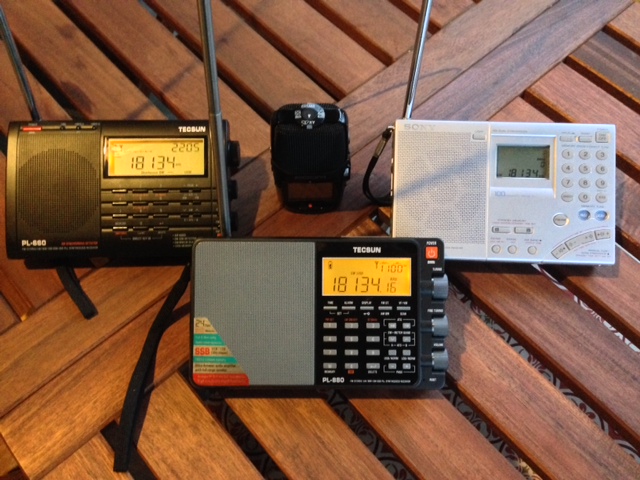
Of course, I’ve spent the bulk of my PL-880 listening time on the shortwaves…where I find the PL-880 a pleasure to operate.
 Tuning
Tuning
The PL-880 sports both broad tuning and fine tuning controls on the right side of the radio. They’re perfectly positioned to be operated with ease by the user’s thumb. They also protrude enough from the right side of the radio so that it can be tuned much like the tuning knob of the PL-660–from the top side of the control.
The keypad on the front of the PL-880 has a quality response/feel. Selecting a frequency is as easy as entering the number in kHz. No other button pushes are needed, much like the PL-660, and the Grundig G3. By pressing the “SW METER BAND” up/down controls, you can move through the broadcast bands with ease. Indeed, if you change the mode to SSB and use the same up/down arrows, the PL-880 will cycle through the amateur radio bands as well. Nice touch, Tecsun!
Tuning increments are in very fine 10 Hz increments with absolutely no muting between frequencies…Brilliant.
The hidden sync lock feature
There was much speculation prior to the PL-800’s introduction as to whether it would have a built-in synchronous detector. After all, its predecessor, the PL-660, has a great sync lock that helps with selective fading and adjacent signal interference. I was very happy to discover that by pressing and holding the USB/LSB buttons, the user can activate an undocumented sync lock feature which is selectable on upper and lower side-bands.
After using the sync lock on a variety of strong/weak signals, I find that I’m not exactly wooed by it, however. The PL-880’s sync detector is just not as good as the PL-660’s–not by a long shot. On weak stations, the PL-880 lock is feeble and wobbly. On strong stations, it makes the audio sound unnecessarily thin and sharp.
A sub-par sync lock is not a deal-killer for me, though. Why? Because I get excellent results by simply using an SSB mode (USB/LSB) and zero-beating the AM carrier. It’s a trick well known in the SWLing world under many names–I call it ECR (exalted carrier reception)–click here for a previous article on the topic. This method rivals the PL-660’s sync lock under similar conditions. And as a bonus, the PL-880 bandwidths can be widened to 4 kHz, allowing near-AM fidelity in SSB.
How does the PL-880 compare with the PL-660, SW7600GR?
A few days ago, I spent some time comparing the shortwave sensitivity and selectivity of the Tecsun PL-880, PL-660, and the Sony ICF-SW7600GR. Instead of shooting a video on my iPhone (which lacks a good mic), I used my newly-replaced Zoom H2N digital recorder with a direct, line-in connection.
I did my best to match the volume levels in the radios for a fair competition. Note that while the Sony and the PL-880 have line-out jacks (a major plus, in my opinion), the PL-880’s line-out audio level is set way too high and overloaded the Zoom recorder; the FM line level can be adjusted, however.
AM Sensitivity
The first test was in AM, and I chose Radio Exterior de España on 9,605 kHz, which was moderately weak compared to other broadcasters on the 31 meter band. I recorded one minute clips. Halfway through the PL-660 and ICF-SW7600GR clips, I turned on the sync detector. On the PL-880, I simply turned on SSB, as I did not feel that its sync detector added to intelligibility.
Click on the radio name to download the MP3 of each clip, or simply listen via the embedded players below:
Tecsun PL-880
Tecsun PL-660
Sony ICF-SW7600GR
SSB Sensitivity
I then tuned all of the radios to 18,135 kHz, where ZD8UW (The Cambridge University Wireless Society) Ascension Island DXpedition was handling a pile-up. You won’t hear stations calling ZD8UW, because they were working split and listening on 18,141 kHz. There is an adjacent SSB station, though, that you’ll hear on the side.
In this test, I had all the radios set to a narrow bandwidth. I had the PL-880 set to 3 kHz as it sounded similar to the others at that width. Since propagation conditions were changing, I made two recordings of one minute’s duration of each radio. I picked the version of the recording in which each radio experienced the same signal strength. Again, you can click on the radio name to download the MP3 of each clip, or simply listen via the embedded players below:
Tecsun PL-880
Tecsun PL-660
Sony ICF-SW7600GR
The PL-880 is certainly sensitive on the shortwave bands, but when listening via headphones (as in this example), there’s sometimes a bit of splatter when the audio peaks. The PL-880 demonstrates great selectivity, as promised. In the SSB example above, the PL-880’s 3 kHz filter successfully rejected the adjacent signal much more cleanly than the narrow filter on the PL-660 could.
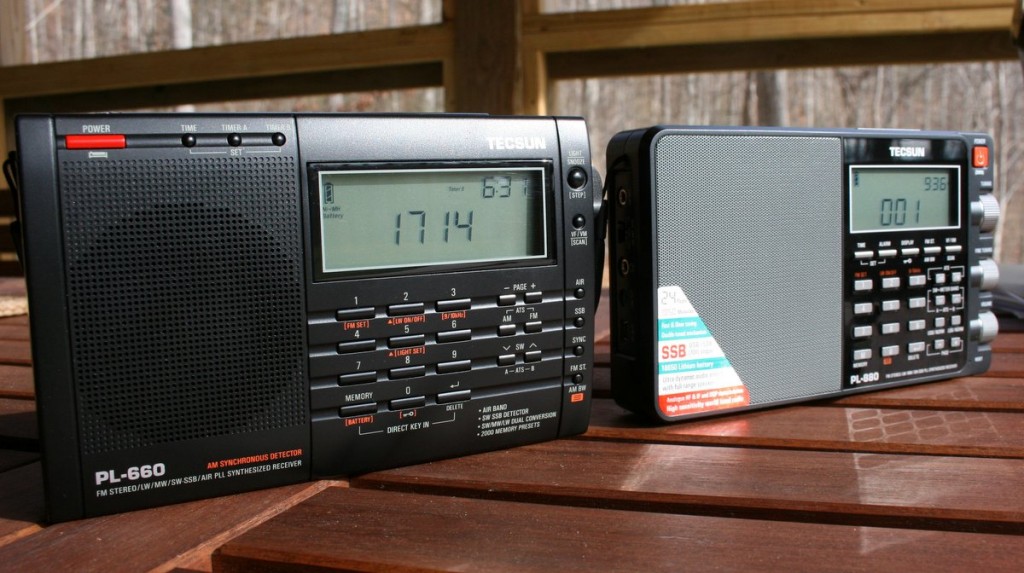
PL-660 vs. PL-880: Which is the better radio?
In my tests, the Tecsun PL-660 does a fine job of holding its own against the PL-880, and is certainly the best bargain of the two at $100-$120 US. In general, I find the PL-660 to have an edge on the PL-880 in terms of sensitivity. While I prefer the audio characteristics of the PL-880’s internal speaker compared to that of the PL-660, vocals seem to pop out of the noise better with the PL-660.
But comparing these two radios in terms of sensitivity is problematic, as it’s not an “apples-to-apples” comparison. In the examples above, I tried to keep the playing field level by leaving the PL-880 on one bandwidth setting and not using the hidden DNR feature (which seems to alter the bandwidth and lower the noise floor). It’s certainly possible some users may be able to tweak the PL-880 to give it an edge on the PL-660 in similar conditions.
Whether or not you should buy the PL-660 or the more expensive PL-880 will clearly depend upon your listening goals. If it’s to pull out voices from the static, for station ID and weak signal DXing, the PL-660 is your radio. If you want armchair listening of shortwave broadcasts with very low listening fatigue, go ahead and splurge for the PL-880. If you want a simple, straightforward portable, the PL-660 is your best option. If you like to tinker with settings, and enjoy all a radio’s bells and whistles–including tracking down hidden ones!–the PL-880 is your radio.
If your goal is to listen to SSB broadcasts (pirate radio, utility stations, ham radio traffic, so forth) both radios will do a fine job, but the PL-880 is more versatile and, again, has better selectivity.
Frankly, I will keep both radios in my listening arsenal. Which will I turn to the most? While I love the PL-660, I’m a sucker for the more dynamic, rich audio of the PL-880. To me, any difference in sensitivity is negligible.
Summary
Every radio has its pros and cons, of course. When I begin a review of a radio, I take notes from the very beginning so that I don’t forget my initial impressions. Following is the list I formed over the time I’ve been evaluating the Tecsun PL-880:
Pros
- Excellent ergonomics
- most functions are either available at the press of button–or by pressing and holding a button for three seconds
- tuning options include a dedicated fine-tuning control
- buttons have a sturdy, tactile feel and response
- Excellent sensitivity and selectivity
- Wide array of filter options in both AM/SSB–more than on any sub-$200 portable on the market
- Absolutely no muting between frequencies, even while using a .5 kHz filter in SSB
- Using SSB ECR is more effective than synchronous detector (see con)
- Sturdy carrying case has dedicated pocket for English operation manual
- Single supplied rechargeable battery delivers very long life (see con)
Cons
- Update: Older firmware versions lack features of newer models
- Two-second delay when changing modes (AM/SSB/AM sync)
- Some audio splatter on peaks in weak signal DX
- Quirky characteristics:
- hidden features (see list at review’s end), some of which have major relevance in operation, such as changing the muting threshold; Tecsun, why hide these?
- unexplained occasional changes in bandwidth while tuning in SSB
- Sync detector delivers mediocre performance and substantially reduced audio fidelity (see pro)
- AM (medium wave) prone to imaging if strong AM broadcasters are nearby
- Supplied rechargeable battery is not as common as AA batteries (see pro)
- Supplied battery charger is a bit noisy on medium wave and shortwave if listening while charging. (Not a problem for me, as I’m a batteries-only listener.)
All in all, I really like the PL-880. It’s a quirky little rig that boasts more features than any other portable I’ve ever used (save the Eton E1). It’s sensitive, selective, has silky-smooth tuning and robust audio…but it’s not perfect. Many of the cons listed above could be fixed with firmware updates…ones which I hope users can make at home as opposed to needing to buy a newly-updated radio.
And, Tecsun, I hope you add those hidden features to future operation manuals. We’re keeping track of them here, and on the Yahoo PL-880 group, but some recipients may never realize the muting threshold, for example, can be adjusted. Tecsun, if you feel like these features aren’t ready for production, simply label them as beta or experimental features, and go for it anyway.
With all of its features and functions, hidden or not, I’ve found the PL-880 to be a challenging, but thoroughly enjoyable, portable to evaluate. Indeed, I’m still not done yet: I plan to take my new PL-880 traveling in the future. So, stay tuned: there’s more to come!
[IMPORTANT UPDATE Dec 14, 2013: Many units purchased at Amazon.com (via Kaito Electronics) have an older firmware version and users report problems and lack of features/functionality. Many have even returned their radios for a refund. At this point, I would exercise caution when making a purchase; you might even wait until Tecsun has either removed the older firmware units from the market or given its users a way to make updates from home. If you want to purchase a PL-880 soon, I can only recommend buying from the same company I did, Anon-Co–see info below. I would verify with them that your unit has the latest firmware.]
Where to buy the PL-880
The PL-880 is only available from a few retailers thus far–most of whom are on eBay, some on Amazon. I purchase all Tecsun products from Anon-Co –I’m sure there are other qualified sellers on eBay, but Anon-Co
–I’m sure there are other qualified sellers on eBay, but Anon-Co has always provided me with excellent and responsive customer service, so I can recommend the company. My PL-880 was shipped by Anon-Co
has always provided me with excellent and responsive customer service, so I can recommend the company. My PL-880 was shipped by Anon-Co and received in only three days. Kaito Electronics, a US-based distributor, also sells the PL-880 on Amazon.com. The price on the PL-880 has been fluctuating over time, but seems to hover between $150-$180 US:
and received in only three days. Kaito Electronics, a US-based distributor, also sells the PL-880 on Amazon.com. The price on the PL-880 has been fluctuating over time, but seems to hover between $150-$180 US:
Appendix
Notes
PL-880 Hidden Features:
Resources
You can follow all Tecsun PL-880 updates by bookmarking/checking this link.
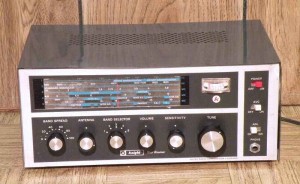 My shortwave experience started in 1967 at the age of 13. My father brought home these old AM/FM/SW tube radios probably dating back to the 30’s and 40’s and asked if I wanted them. That’s all it took and my first QSL is dated May 20, 1967 from Radio Cairo, Egypt. I found out from my cousin that if you wrote the station a letter telling them what you heard, that they would send back a verification in the form of a card, pennant, or letter. Today my count for unique verifications is well over 500 with numerous “goodies” that I have received over the years.
My shortwave experience started in 1967 at the age of 13. My father brought home these old AM/FM/SW tube radios probably dating back to the 30’s and 40’s and asked if I wanted them. That’s all it took and my first QSL is dated May 20, 1967 from Radio Cairo, Egypt. I found out from my cousin that if you wrote the station a letter telling them what you heard, that they would send back a verification in the form of a card, pennant, or letter. Today my count for unique verifications is well over 500 with numerous “goodies” that I have received over the years.
